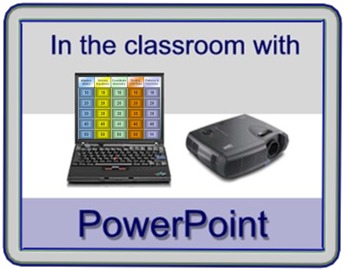 |
Bingo Boarding |
 |
Bingo Boarding |
PPT Menu Page | MathBits Main Page | Terms of Use
This activity was designed for reviewing 8th grade standard topics of
combining like terms, creating algebraic expressions,
Pythagorean Theorem, solving equaitons, ratios,
rate, adding polynomials, percents, angles and parallels,
GCF, vertical angles, distributive property,
inequalities, surface area, exponents, slope, volume, reflections,
scientific notation, supplementary/
complementary
angles, area/circumference of circles, and fractions with 8th grade students.
8th Grade Math
| Sample slide shots ...... |
Possible Ways to Use This Activity in the Classroom: To Play traditional Bingo Game as a Class: 2. Ask students to number the card in any random fashion (of their choosing) from 1 to 24 (assuming a "Free Space") or 1 to 25. (This game has 25 slides if you want to use ALL squares.) The students are making their own cards. 3. Project the Bingo Game slides and stop on the Bingo Board. 4. As the "BINGO caller", you need to pick a number from 1 to 24. You can do this by rolling a die (game stores have multi-sided die), using a spinner, picking numbers from a bag, or generating the random number on your graphing calculator.
5. When you announce the number, click on that number from the Bingo Board to show the question. Students solve the problem and place their answer on their BINGO card in the box containing the number of the question. 6. BINGO is achieved in the normal manner – horizontally, diagonally, and vertically (or 4 corners if you wish). 7. Students raise their hands if they have BINGO. You check the answers to see if the student has won. 8. When a student wins, EVERYONE continues playing on the SAME card, including the winning student (he/she could win again). Place a red line through the win line so the student can continue playing. 9. You can play until all the problems have been solved, or you can stop after 5 or 6 students win. Stopping after 5 or 6 students usually covers approximately 70-85% of the problems. Tell the students in advance that you may be ending early, so they do not BEG you to continue saying "I only need one more to win!" 10. Collecting student work at the end of the game will ensure everyone's participation. Suggestions: 1. If there is a particular problem among the slides that you want the students to solve, you may "throw" the die in the direction of that number. Smiles! Do not, however, do this too often. 2. Offering "prizes" is a wonderful motivator, but is not a mandatory aspect of this activity. Prizes can be candy, "free" homework cards, exemption from an assignment or short quiz, holiday pencils, trinkets (whatever is easily available) or a simple posting of the BINGO winners on the classroom wall. Candy seems to be the most popular prize. : ) 3. If you think the students will have trouble solving the problems, you can have students work in pairs (but each student should maintain his/her own card), offer hints while the students are working, ask for class discussions of the solutions, and/or even show the answer screens to be sure everyone is understanding the concepts. 4. This is a "fun" activity that is a wonderful motivator. We have used it with classes ranging from "general" math to AP Calculus and it is always successful. Other Options: 1. Short Class Activity: Set an activity "number" ("This activity will require that we answer five questions from the Bingo Board.") Let volunteers choose questions. The task is for each student (working alone or in groups) to show HOW to solve each question. None of the work needed to arrive at the final answer is shown on the slides, for this purpose. 2. Quiz: Pick the questions that you wish to show for a quiz. Do not click on the "See answer" button. Show only your questions. Answers can be shown after the quiz is completed. 3. Assign as Independent
Review: Students can work independently using
the On-Line activity for additional practice. Students must supply "all the work" needed to arrive at the answer, or be ready to explain the answer if called on in class. Used in a Computer Lab or Laptop
Setting: 2. Lab Quiz: Pick the questions that you wish to use for the quiz. Put the question numbers on a worksheet with sufficient work space next to each question for the work to be shown. The task is for each student, working alone, to show HOW to solve each question. Yes, they can look at the answer -- but as we all know, the "good stuff" is in the trip TO the answer. 3. Assign as Independent Review: Students can work independently using the On-Line activity for additional practice. |
PPT Menu Page | MathBits Main Page